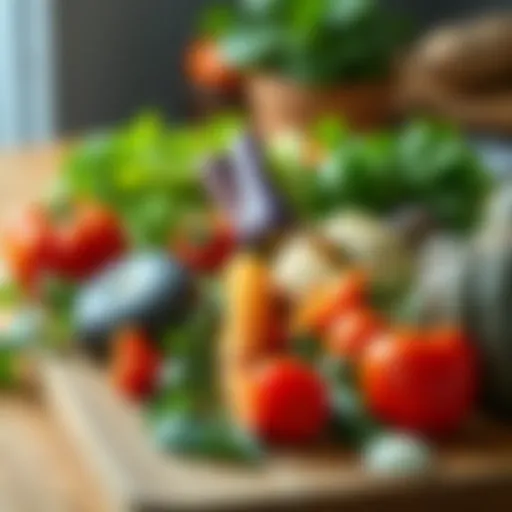Essential Vegetables for Your Garden: A Comprehensive Guide
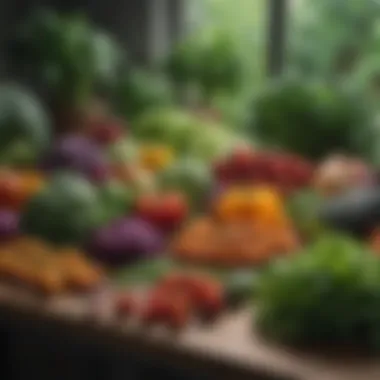

Intro
Creating a vegetable garden is both a rewarding and satisfying endeavor. However, the right selection of vegetables plays a large role in its success. Different vegetables have different needs based on climatic conditions, soil types, and individual preferences for taste and nutrition.
This guide will delve into essential vegetables that are not only easy to grow but also offer a variety of flavors and health benefits. For novice gardeners, this can seem overwhelming. Each step toward cultivating your garden can be simplified with the right knowledge. This article will provide essential information on choosing suitable vegetables, understanding their needs, and the processes involved in sustainable gardening.
Ingredients Breakdown
Primary Vegetables
- Tomatoes: These are diverse in their varieties and prefer warm weather. They can produce a high yield of fruits for salads and sauces.
- Carrots: Rich in nutrients, carrots thrive in loose, sandy soil and are perfect for cool climates.
- Lettuce: Fast-growing and easy to care for, lettuce offers many varieties that cater well to partial shade.
- Potatoes: A staple for many diets, they're best grown in well-drained, loose soil and require some space to spread.
- Bell Peppers: These require a warm climate and well-drained soil, offering sweetness and versatility.
Optional Ingredients
- Herbs: Varieties like basil, parsley, and cilantro enhance flavors and can easily grow with little space.
- Radishes: Quick to harvest, radishes can be great companions in the garden and do well in cooler temperatures.
- Spinach: Leafy greens like spinach grow best in cool seasons and provide abundant nutrition.
Essential Gardening Tools
- Hand Hoe: Perfect for cultivating and managing the soil around your plants.
- Watering Can or Hose: Ensure consistent moisture levels without over-saturation.
- Garden Gloves: Protect your hands while working with soil and plants.
- Trowel: A small digging tool to facilitate planting and transplanting seedlings.
- Pruners: Essential for maintaining plant health and enabling better growth.
For a successful garden, choose vegetables suited for your climate and space, considering their practical needs and your culinary desires.
Step-by-Step Preparation
Prepping the Ingredients
Before planting, consider starting seeds indoors in seed trays, especially for tomatoes and peppers. Once the threat of frost has passed, transplant them outdoors. Prepare your garden beds by tilling the soil and adding ample organic matter like compost to enhance fertility.
Growing Techniques
Make sure to follow a crop rotation schedule to prevent nutrient depletion and pest build-up. Square foot gardening can be useful as it maximizes space and increases yields. Regularly monitor moisture levels to ensure plants thrive without excess water.
Assembly and Presentation Tips
Grouping plants creatively not only saves space but also adds beauty to your garden. Companion planting can boost yields, where for instance carrots and onions can thrive in proximity.
Dietary Considerations
Nutritional Profiles
Different vegetables contribute unique nutrients. For example, tomatoes provide significant amounts of vitamins C and K, while carrots are rich in beta-carotene.
Considerations for Diets
Most vegetables can fit fittingly within vegetarian and vegan diets, promoting health and sustainability. These can offer fiber, essential vitamins, and minerals.
Variations and Customizations
Flavor Triangulations
Grown together, herbs can change the flavor of vegetables immensely. Pairing tomatoes with basil or spinach with garlic adds culinary depth.
Modern Farming Techniques
Consider flexible growing systems, such as vertical gardening or hydroponics. This not only saves space but addresses urban gardening needs.
Pairing Suggestions
Consider complementing your vegetable harvest with grains, pulses, or local cheeses, depending on dietary preferences. Each combination offers distinctly unique dishes.
Common Questions and Answerss and Troubleshooting
Frequently Asked Questions
- What vegetables grow best in small spaces?
Herbs, radishes, and compact varieties of peppers can thrive in containers. - How do I know when to harvest?
Each vegetable varies in ripeness. Common indicators include firm texture or a change in color.
Common Mistakes to Avoid
Underestimating sunlight needs can contribute to poorly developed vegetables. Always research the specific requirements for each plant.
Solutions to Problems
Pests can overwhelm a garden if not managed. Using organic pest control or companion planting techniques can mitigate such issues.
In summary, this guide serves to equip growers with essential knowledge about suitable vegetables, gardening techniques, and practical approaches to achieving a satisfied and sustainable vegetable garden.
Intro to Vegetable Gardening
Vegetable gardening serves as both a practical endeavor and a source of pleasure for many individuals. It is an essential skill that enables people to grow their food, connecting them with nature and fostering sustainable habits. In this section, the focus will be on understanding the gardening space and exploring the benefits of cultivating your own vegetables.
Understanding Your Gardening Space
When starting with vegetable gardening, the first step is recognizing the parameters of your gardening area. Factors such as space availability, sunlight exposure, and soil type play crucial roles in your success. Initially, measure the dimensions of the area designated for cultivation. Knowing your garden's layout will help determine the types of vegetables that can thrive.
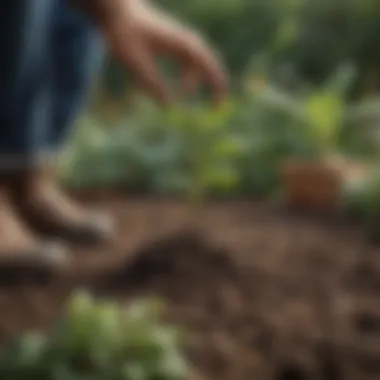

Consider optimal sunlight exposure as well. Most vegetables need approximately six to eight hours of direct sun daily. Observe the sunlight patterns in your selected space to ensure your plants receive optimal lighting. Assessing soil type is just as critical; well-drained loamy soils are generally preferred for vegetable growth. Augmenting your soil with compost is beneficial and improves nutrient content.
Why Grow Your Own Vegetables?
Growing vegetables at home resonates deeply for various reasons, both personal and ecological. The most apparent benefit is the nutrition derived from home-grown produce. Freshly harvested vegetables often burst with flavor and are laden with nutrients compared to store-bought options.
Another compelling reason is the cost-efficiency. Although initial investments in seeds and gardening supplies may feel substantial, over time, the savings accumulated from not purchasing commercial vegetables become evident. The joy and satisfaction associated with self-grown vegetables are often, to some extent, incomparable. You experience full control over what goes into your body through your plants. This control includes deciding not only the type of fertilizers used but also ensuring the avoidance of harmful pesticides.
The act of gardening itself connects people to the earth. Maintaining a vegetable garden can become a treasured hobby or a family activity. It nurtures patience, discipline, and appreciation for natural processes.
Key Takeaway: Gardening encourages self-sufficiency, contributes to environmental welfare, and promotes healthier choices through direct access to fresh produce.
On the whole, introducing vegetable gardening into your lifestyle opens the door to numerous benefits. As we progress in this guide, the principles discussed will equip readers with valuable information to create thriving vegetable patches tailored to individual needs.
Key Factors to Consider
Understanding the essential factors in creating a flourishing vegetable garden is vital for both novice and seasoned gardeners. Selecting the right vegetables based on specific variables can determine the success or failure of the gardening endeavor. It addresses climate adaptability, soil health, and hydration requirements among other critical conditions. Optimizing these factors leads to better yields, healthier crops, and ultimately a more rewarding gardening experience.
Climate and Growing Conditions
Climate plays an important role in gardening since vegetables require certain conditions to grow optimally. Weather patterns such as temperature ranges, precipitation levels, and seasonal changes are significant. Each vegetable variety has specific climate requirements, from cool-season crops which thrive in the cooler months to warm-season vegetables suited to hot environments.
Consider the USDA Plant Hardiness Zone Map when selecting vegetables for your garden. This map classifies different regions according to their average annual minimum temperature. Knowing your zone helps in selecting reputable vegetables that are more likely to thrive in your area.
Furthermore, the exposure to sunlight and protection from extreme weather is significant. Vegetables such as tomatoes demand full sun, often requiring at least six to eight hours of direct sunlight daily. Planning accordingly with rows or densities can allow for maximal exposure. Therefore, local climate familiarity enhances your ability to optimize growing seasons and select the appropriate vegetables.
Soil Quality and Preparation
Soil is the foundation upon which successful gardening is built. The quality of the soil affects nutrient availability and hydration, which are critical for plant growth. Prior to planting, conducting a soil test can determine its pH levels and nutrient composition. Depending on these results, amendments may be necessary to achieve suitable soil fertility. This is particularly important because different plants prefer differing soil conditions.
For instance, root vegetables such as carrots and beets thrive in loose, well-drained soil that provides space to expand, while leafy greens prefer rich, organic compost. Adding substances like organic matter or specialized fertilizers can enhance soil performance. Additionally, tilling or aerating the ground before planting encourages properly compacted soil, allowing roots to grow well and access water and nutrients smoothly.
Spend time on proper soil management as enriched baking, mulching, and structured rotation make a significant difference.
Watering and Sunlight Requirements
All plants need water, but the amount and frequency depend on the vegetable variety as well as environmental conditions. Generally, it is best to water plants at their base to reduce evaporation and help area dry faster. Most vegetables benefit from about one to one-and-a-half inches of watering per week, especially during hot or dry weather.
Incorpora*ting techniques like drip irrigation improves water efficiency and reduces fungal diseases by keeping foliage dry. Awareness about whose vegetables are drought-resistant versus those that require regularly moist soil can determine your gardening strategy.
Moreover, sunlight is another critical factor. Not all plants need the same light intensity. Vegetables like leafy greens enjoy partial shade, especially during hotter months, while other plants such as peppers and eggplants prosper in consistently sunny beds. Determining positioning and planting instructions based on light intensity will prevent stunted growth and ensure plants have the right conditions for viability.
Understanding these key factors can guide gardeners to greater success and satisfaction. Proper planning and consideration of climate, soil, and sunlight can create a drawable experience designed to not just grow fresh produce but allow for a richer understanding of vegetable gardening.
Popular Vegetables to Grow
Growing vegetables at home offers various benefits. Choosing the right types can facilitate healthy eating habits and improve the sustainability of our food sources. This section delves into various categories of popular vegetables, encouraging diverse selections for different preferences and growing conditions.
Leafy Greens
Spinach
Spinach is a highly nutritious leafy green, known for its vitamins A, C, and K, as well as iron and magnesium. It accomplishes exceptional growth in cool weather, making it ideal for spring and autumn planting. One key characteristic of spinach is that it grows rapidly, allowing multiple harvests within a single growing season. Its versatility as a salad base or a cooked dish makes spinach an integral choice for many home gardens. The primary advantage lies in its ability to thrive in various soil and climate conditions; however, poor drainage can lead to rot, necessitating careful attention during planting.
Kale
Kale has been gaining popularity due to its impressive health benefits and sturdy nature. It's often referred to as a superfood, packed with antioxidants, fiber, and several vitamins. florets make it aesthetically pleasing as it comes in various colors. One of its unique features is tolerance to frost, which enhances its sweetness. Kale can be harvested gradually as individual leaves mature, providing a steady supply throughout the winter months, especially beneficial in colder climates. Additionally, keeping the soil enriched ensures optimal growth, while over-fertilization should be avoided.
Lettuce
Lettuce draws interest as a staple salad ingredient due to its crisp texture and refreshing taste. It is quite adaptable, with various breeds available catering to different preferences, such as crispheads, butterhead, and looseleaf varieties. Its fast-growing nature, which allows for repeated sowing and harvesting, makes it approachable even for beginners. The main disadvantage occurs in hot weather, where many types tend to bolt quickly, resulting in better taste getting compromised. Therefore, knowing the intra- and interspecies sowing dates can lead to a better yield.
Root Vegetables
Carrots
Carrots, popular for their natural sweetness, are packed with nutrients like beta-carotene and fiber. They grow well in sandy and well-drained soil, making their cultivation focused on proper soil samples considerably more opportunistic Though establishing the seedlings might take a little longer when compared with other vegetables, they develop a rewardingly hearty, crisp carrot. Their unique feature is the wide variety, not just orange, but purple, yellow, and white offerings expand the culinary options further. On the downside, they can face pest challenges from root maggots.
Beets
Beets stand out for their vibrant color and sweetness, rich in vitamins and minerals. They require cool weather for optimum growth, with both their roots and greens being edible. One of the key characteristics they offer is the ability to consume both the beetroot and its leafy greens, giving multiple expressions in the kitchen. In terms of disadvantages, they can encounter issues with aphids or diseases, emphasizing the importance of monitoring their health during growth.
Radishes
Radishes are ideal for quick produce and grow fast with minimal space, often ready within three to four weeks. They offer a crisp and slightly spicy flavor profile, enriching salads and dishes. Broad selection means colors and sizes vary widely. Over-sowing can occur, causing competition for resources, so ensuring adequate space for each plant is imperative. They remain productive in cooler conditions but can become woody and strong flavored in warmer conditions.
Fruiting Vegetables
Tomatoes
Tomatoes are perhaps the most beloved fruiting vegetables globally, renowned for their culinary versatility. Rich in vitamins C and K as well as lycopene strengthens the advantageous nature of tomatoes. Indeterminate varieties allow for extended harvesting seasons, keeping fresh fruits coming for longer periods. Nevertheless, one unique feature requires careful management of diseases and pests, making diligence pivotal for successful growth. They are especially sensitive to excess moisture during late stages, thereby timely fetching lavender against botrytis is crucial.
Bell Peppers
Bell peppers bring color and sweetness to dishes and offer various health benefits. They are available in multitude of colors, each bearing different nutritional profiles. Their growing season might benefit significantly from the warm climate and consistent watering, encouraging deep flavor development. One possible disadvantage comes from their ability to suffer from blossom drop, often situational due to environmental conditions or young seedling failure.
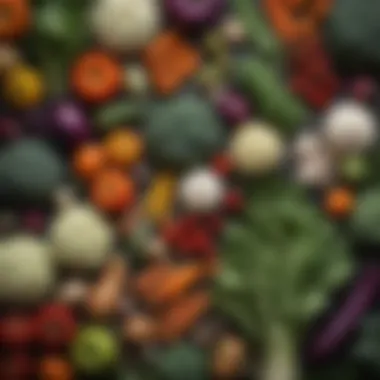

Eggplants
Eggplants have a unique texture and flavor profile, popular in various cuisines, from Mediterranean to Asian dishes. Known for their adaptability in different soil types and growth environments, one prominent feature is their efficient production with every plant bearing multiple fruits. However, challenging weather conditions like excessive heat might impede growth, while they also present vulnerabilities against pests like aphids.
Legumes
Beans
Beans promote soil health by fixing nitrogen levels in the earth. These are incredibly easy to grow and harvest within a few short months, allowing for quick remuneration. Their ability to succeed in various climates adds to their broad appeal, adapting various growth forms like pole or bush beans. On the downside, beans may be susceptible to certain dreaded fungal diseases, mining into sowing techniques can reduce this ailment, making attendance important.
Peas
Peas represent delightful and sweet flavor suitable for cool weather. Their rapid growth and productivity heighten interest during early seasons. They also offer multifaceted use in kitchens and pair elegantly with many dishes. That said, their unique dependency on substantial support arrangements makes strategic placement essential to sustain premature growth. Overly warm conditions can adversely affect production too.
Herbs
Basil
Basil appears vital due to its focal role in countless dishes, offering a fragrant and fresh flavor profile. Its growing strategy adapts easily with proper space between seedlings resulting in better yields. Encouragement under heat complements flavor advancements. One disadvantage might manifest in frequency of pest invasion however, impacting new growers immediacy abilities so workers should use diluted teaspoon mix regularly.
Cilantro
Cilantro offers fresh and zesty notes to divergent dishes. It stays appreciative as it highly complies with climate variations, which researchers and traditional chefs frequently endorse unto summer gardens. Being temperamental and observable in nature, serrated leaves create diverged culinary experiences. A major downside confronts bolting that limits beet sprout availability requiring timely monitoring.
Parsley
Parsley serves diverse purposes, favored spring vegetables widely promoting garnishes or enrichments alongside primary palate components extensively involving nitrogen compound delivery inclusive furthers ratios conversion to become vegetation completete exhaporascii on farm methodologies aided unsurely behavior monitoring for respective valid yield over upfront modular aspects.
Strategies for Successful Gardening
Gardening is an intricate balance of art and science. Strategies for successful gardening play a crucial role in maximizing both yield and sustainability. This section aims to illuminate methods that enhancedont productiveness and help gardens thrive through varying climactic conditions and environmental challenges.
Crop Rotation
Crop rotation is the practice of changing the location of various plant families in the garden every growing season. This can prevent nutrient depletion in the soil and reduce the buildup of pests and diseases. When you plant different crops each year, it helps improve soil health by facilitating various organisms to flourish. Factors like nutrient needs and growth times for crops can widely differ and switching crops takes advantage of this.
- Nutrient Management: Different vegetables require varying nutrients from the soil. For example, heavy feeders like tomatoes are best followed by crops that are light feeders, such as leafy greens. This strategy ensures nutrients are used maximally and replaced when rotated.
- Weed Control: Rotating crops can also disrupt the lifecycle of weeds by changing ideal growing conditions. This will take your effort in keeping gardens tidy and clean significantly lower.
Companion Planting
Companion planting refers to the method of growing two or more different plant types in proximity for mutual benefits. Plants can interact with one another in ways that enhance growth, repel pests, or conserve resources. This is not just helpful for maximizing dairy production but also increases plant vitality.
- Pest Deterrence: Some plants can deter pests that commonly afflict their neighbors. For instance, marigolds are known to repel nematodes and other harmful insects when planted among vegetables.
- Utilization of Space: Different plants' growth habits, such as vine plants growing alongside upright plants, allow the gardener to use limited space more effectively. This promotes better access to sunlight and maximizes potential harvests.
Pest and Disease Management
Implementing effective pest and disease management strategies is fundamental to maintaining a healthy vegetable garden. Disease can run rampant, but understanding and noting common protocols can save plants and ensure a greener future.
- Integrated Pest Management (IPM): This is a holistic approach to managing pests. It combines various management strategies such as cultural, physical and biological controls, along with, when necessary, a more targeted use of chemicals along with close monitoring of plants.
- Awareness and Identification: Knowing what common pests and diseases can occur helps during the early intervention stages. For example, recognizing signs such as aphids on plants can prompt early strategies such as introducing predatory insects or using soapy water to naturally eliminate pests.
These methods should be embraced by both novice and experienced gardeners. They provide a structure for optimizing both plant care and yielding a more sustainable gardening practice.
Seasonal Planting Guide
Understanding the concept of seasonal planting is vital for maximizing the yields and efficiency of your vegetable garden. Vegetables have specific growing windows during which they thrive best, influenced by climate, temperature, and seasonal weather patterns. Planting your crops in accordance with the season not only enhances their vigor but also supports sustainable gardening practices. Gardeners can cultivate a continuous supply of fresh produce throughout the year by adhering to seasonal planting timelines.
Spring Planting
Spring is traditionally a time of rebirth in nature, making it the perfect season to start garden activities. As frost recedes and soil begins to warm up, vegetables that tolerate cooler temperatures can be sown. Early planting includes vegetables like peas, bok choy, and radishes. These varieties enjoy the mild and wet conditions that spring typically offers.
Specific considerations for spring planting include:
- Soil temperature: Use a soil thermometer to check that soil has warmed sufficiently for optimal germination.
- Frost dates: Familiarize yourself with your area’s last frost date to avoid planting too early.
- Short growing seasons: Focus on faster-growing crops to maximize harvest time.
Summer Planting
As temperatures climb in summer, the choice of vegetables shifts to those that thrive in warm conditions. Popular summer crops include tomatoes, bell peppers, and zucchini. One important aspect of summer planting is to ensure ample water supply. Heat can lead to faster drying of soil, impacting plant health.
Consider the following for summer planting:
- Mulching: Employing mulch helps retain soil moisture, keeping roots cool.
- Staggered planting: Plant in intervals to extend harvesting periods and ensure a constant supply of fresh produce.
- Heat tolerance: Choose varieties proven to thrive in high temperatures; for example, sun gold tomatoes or jalapeño peppers are suitable choices.
Fall Planting
Fall marks a transition from warm to cooler weather, and it gets overlooked by novice gardeners. This season is ideal for planting crops that can withstand chilling temperatures. Varieties such as kale, carrots, and broccoli are synchronicities with fall planting.
Key considerations for fall planting include:
- Daylight hours: With shorter days away from the equinox, consider the variations affecting plant growth; opt for quick-maturing crops.
- Preparing for frost: Use shade cloths or row covers to shield hardship crops from unexpected early frosts.
- Soil enrichment: Adding compost before planting fall crops helps develop robust roots that stand up to winter conditions.
Winter Gardening Techniques
Winter gardening requires more creativity because cold generally inhibits growth. However, techniques such as using cold frames and greenhouses can extend the growing season for hardy vegetables like spinach, garlic, and leeks.
Incorporate these techniques into your winter gardening:
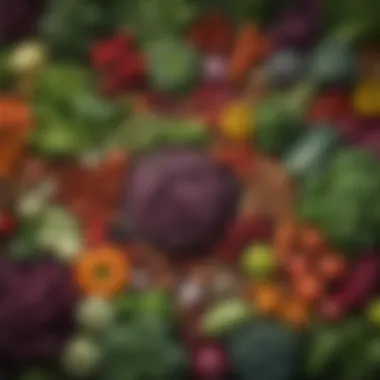

- Cold frames: These allow sunlight to warm seedlings and protect them against harsh winds.
- Indoor gardening: Consider container gardening with appropriate indoor lighting for fresh herbs during winter months.
- Soil mulching: Applying mulch protects the roots from severe temperature fluctuations.
Maximizing Space in Your Garden
Maximizing space in your garden is crucial for optimizing your growing potential. Today’s gardeners often face space constraints, whether due to small yards, urban settings, or limited access to land. Understanding how to best utilize the available area can increase your yield and enhance the overall gardening experience.
Using various techniques not only helps you grow more food but also allows you to create a visually appealing garden. This section describes the most effective space-saving strategies, highlighting vertical gardening, raised bed gardening, and container gardening.
Vertical Gardening
Vertical gardening stands out as an effective solution for capitalizing on limited space. This method involves using vertical structures to support plant growth. By extending gardening upward, you can fit more plants in a smaller area while maintaining accessibility.
You can make use of trellises, fence fixtures, and other vertical supports. Here are a few key vegetables ideal for vertical gardening:
- Cucumbers thrive when trained to climb, making them suitable for vertical gardens.
- Tomatoes, especially indeterminate varieties, can produce larger yields when planted vertically.
- Beans also grow well upward, taking little horizontal space.
Equipment that assists in vertical gardening can be large or compact. Pallet gardens and designated stakes work well even in tight corners. Ensure proper sunlight exposure and ample water flow, as vertical setups can sometimes complicate these factors.
Raised Bed Gardening
Raised bed gardening benefits gardeners in multiple ways. These beds can offer better drainage, which reduces the risk of root rot and encourages healthy growth. Furthermore, they often use quality soil blend that supports diverse growth potential.
Building a raised bed does not require too much effort. Simply outline the area, fill it with chosen soil and nutrients, and you are set. The height of the bed also allows for easy access, making weeding and harvest more convenient, especially for those with mobility issues.
Here are some essential points about raised bed gardening:
- Higher soil temperatures can lead to earlier planting and extended growing seasons.
- The continuous access to nutrients minimizes the need for over-fertilization.
- Installation of boundaries can help prevent soil erosion from heavy rains or watering.
Container Gardening
Container gardening presents another opportunity for efficient space usage. Perfect for those living in apartments or places without traditional garden beds, pots and containers can be strategically placed on balconies, patios, or even windowsills.
It’s necessary to choose containers with proper drainage. Shooting vegetables, herbs, and smaller plants suit best in containers. Many easily adaptable vegetables for container gardening include:
- Lettuce, which can be grown in a shallow container for easy access and cutting.
- Radishes: Their quick-growing nature is perfect for smaller spaces, offering early harvests.
- Herbs are well-suited for containers as they can furnish flavor-ready selections for various dishes.
Using container gardening techniques also permits easy rotation and mobility of studies. Regularly updating soil and nutrients keeps plants healthy and vibrant. Consider self-watering pots for more hands-off care. Understanding each option’s characteristics will open the door to better production in your garden while being space-efficient.
Sustainable Gardening Practices
Sustainable gardening practices are an important aspect of cultivating a vegetable garden that is healthy for the environment and beneficial for the gardener. In the current climate of ecological concern, adopting sustainable practices is not just responsible but essential. These methods aim to promote biodiversity, enhance soil health, conserve water, and reduce the reliance on chemical inputs. This section explores key techniques like composting, water conservation, and the use of organic fertilizers, ensuring a fruitful and ecologically sound gardening experience.
Composting
Composting transforms organic waste into nutrient-rich soil amendment. By composting kitchen scraps, yard waste, and other biodegradable materials, gardeners can recycle nutrients back into the soil. This process contributes to a healthier garden ecosystem. The benefits of composting are multifaceted:
- Enhances Soil Quality: Compost improves soil structure, aeration, and fertility.
- Reduces Waste: Diverts organic material from landfills, reducing greenhouse gas emissions.
- Promotes Plant Health: Provides a balanced source of essential nutrients, boosting plant growth.
Creating compost involves a few simple steps. Keep a mix of green materials (fruit and vegetable scraps, grass clippings) and brown materials (dry leaves, newspaper). Regularly turn the pile to promote aeration. Within several months, the compost will decompose into a rich, dark material you can add to your garden soil.
Water Conservation Techniques
Proper water management is vital in sustainable gardening. Water conservation techniques not only help to conserve this precious resource, but they ensure the garden remains productive, even in periods of drought. Some effective practices include:
- Drip Irrigation: This method delivers water directly to the plant roots, minimizing evaporation and runoff.
- Rainwater Harvesting: Installing barrels to collect rainwater provides an excellent source of irrigation that reduces demand on municipal water supply.
- Mulching: Applying a layer of organic material on top of the soil retains moisture and suppresses weeds.
Incorporating these techniques into your gardening routine boosts efficiency and aligns with sustainable principles. Careful water use leads to stronger plants and a healthier environment.
Using Organic Fertilizers
Organic fertilizers offer an alternative to synthetic fertilizers by enriching the soil naturally. These fertilizers are derived from natural sources like plant material, animal manure, and mineral deposits. Here are some advantages:
- Improves Soil Health: Organic fertilizers enhance microbial activity, leading to a more resilient soil environment.
- Minimizes Chemical Runoff: Using organic alternatives reduces the risk of contaminants entering local waterways.
- Supports Biodiversity: Staying organic encourages a diverse range of organisms, from beneficial insects to earthworms, hence strengthening the garden's ecosystem.
Popular organic fertilizers include composted manure, bone meal, worm castings, and seaweed extracts. Responsible application ensures plants receive necessary nutrients without degrading the health of the soil or surrounding environment.
Sustainable gardening is about making choices that ensure a lasting and healthy relationship with the earth. This approach leads to vibrant benefits for both gardeners and the ecosystems they nurture.
Finale
Understanding the importance of concluding thoughts in this article can greatly enhance a gardener's experience and responsibilities in vegetable cultivation. Overall, engaging in vegetable gardening can bring positive aspects not only to personal health but also to environmental impacts.
The Rewards of Vegetable Gardening
The rewards of vegetable gardening extend beyond the pleasing visuals in one’s backyard. Nutritious home-grown food ranks as one of the foremost benefits. It offers fresh items free of harmful pesticides and other chemicals.
Gardening also presents an opportunity for individuals to learn about the life cycle of plants. This knowledge helps in recognizing the necessary sustenance plants require, assisting in better cultivation efforts. The satisfaction of harvesting your own vegetables can create a fulfilling experience, instilling a sense of accomplishment and self-sufficiency.
Moreover, diverse plantings can lead to a healthier ecosystem. Plants contribute positively to biodiversity while attracting useful insects that aid in pest management. Being surrounded by greenery supports mental health and well-being, reducing stress levels and fostering tranquility.
Growing your own vegetables not only nourishes the body but also nourishs the soul.
Encouraging a Gardening Mindset
Cultivating a gardening mindset can truly be beneficial. To achieve this, individuals should approach gardens with curiosity and a willingness to learn. Each type of vegetable holds a lesson, whether it is about growth patterns, seasonal changes, or pest interactions. Embracing these experiences can lead to improved gardening skills.
Patience plays a crucial role in developing this mindset. Gardening is about understanding that not all factors are controllable. Weather can change, and plants may react unpredictably to conditions, but patience fosters resilience and adaptability.
Furthermore, engaging in community gardening or sharing tips on platforms like reddit.com can deepen appreciation for vegetable gardening. Collaborating with others promotes camaraderie and may introduce new gardening philosophies while reinforcing shared knowledge.
In summary, the journey through the rewards and mindset of vegetable gardening enhances various aspects of life. It increases sustainability consciousness, promotes healthier diets, and fosters stronger community ties.

